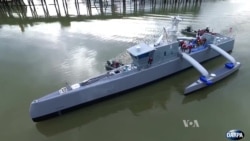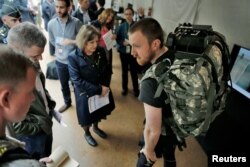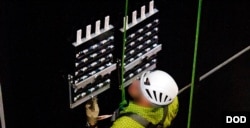Unmanned submarine hunters, gecko-inspired wall climbing material and even "upward falling" containers that spring into action from the ocean floor — that's just a taste of the U.S. military's latest technological innovations on display Wednesday at the Pentagon.
The Defense Advanced Research Projects Agency, better known as DARPA, showed off more than 60 of its inventions, concepts and programs as part of the agency's Demo Day. The annual event provides the Defense Department community with an up-close look at projects in various stages of development and readiness.
The technological creations range from those intended for use from undersea to outer space. They aim to improve all aspects of warfare, from ground combat to cyber, even developing "seeds of surprise" — what one official described as projects that are "above and beyond what the enemy would ever expect."
Check out VOA's Facebook page for a Facebook Live discussion about some of VOA's favorite innovations the U.S. military's research wing has to offer.
WATCH: Unmanned Vessel Could Detect, Track Enemy Submarines
Anti-submarine continuous trail unmanned vessel (ACTUV)
This unmanned surface vessel is 40 meters long and just 3.3 meters wide. (Only a small-scale version made it into the Pentagon.) It weighs 127 metric tons and can travel 10,000 nautical miles on a single tank of gas.
While this skinny ship would be "hyper-cramped" for humans, said DARPA spokesman Jared Adams, it could detect and track enemy submarines, and even could be used to run security perimeters around aircraft carrier groups.
ACTUV would therefore decrease the number of sailors needed to defend a carrier, saving the military tens of millions of dollars spent on crew members currently needed to carry out the same level of defense.
"You could build maybe 50 of these for the price of one warship," Scott Littlefield, ACTUV program manager, told VOA.
Littlefield said the new vessel would be a much safer option when sailing in dangerous waters.
"Because it's unmanned, we can take a lot more chances with it," he said. "Ultimately in a war, if you lost this, but you didn't lose a manned warship, that's a trade we want to be able to make."
An ACTUV vessel is stationed off the coast of San Diego.
Upward falling payloads (UFP)
The Upward Falling Payload concept is intended to create unmanned, nonlethal systems that lie on the ocean floor for years at a time. The military plans to remotely activate these deep-sea nodes when needed to "fall upward," or be pushed to the ocean surface.
DARPA's website says these pre-positioned nodes could enable a full range of maritime mission sets in a more cost-effective manner than existing assets.
This program is in the second of three phases, according to Adams.
Geckskin
"Geckskin" is a product of the Z-Man program, which seeks to build synthetic versions of the biological systems of geckos and spiders to optimize a human's climbing ability with heavy combat loads — without the use of ropes and ladders.
The synthetically fabricated reversible adhesive was inspired by the gecko's ability to scale various vertical surfaces, according to DARPA's website.
Geckskin is a stiff fabric with a rubber-like substance that could enable increased adhesion. DARPA says a "proof-of-concept demonstration in 2012 showed that a 16-square-inch sheet of Geckskin adhering to a vertical glass wall could support a static load of up to 660 pounds," or about 270 kilograms.
WATCH: Plan X Maps Out Invisible Realm of Cyberspace
Plan X
Plan X is a cybersecurity program that maps out the invisible realm of cyberspace, known by Plan X developer and former Marine Frank Pound as a "cyberbattlefield."
Without Plan X, computer analysts must read thousands of data points gathered through hours of system monitoring to see a cyberattack. Plan X simplifies the process in a user-friendly platform that allows a person to view cyberwarfare as if he were viewing kinetic warfare.
"This is something that commanders up in U.S. Cyber Command can use to keep track of all their cybermission forces, what missions they are executing in cyberspace, how those missions are behaving, what units are involved and things like that," Pound said.
Since VOA first reported on Plan X last year, it has moved from a very early prototype stage to a functional prototype. Pound said the latest version of Plan X would participate in a national exercise called Cyber Guard in Suffolk, Virginia next month.














